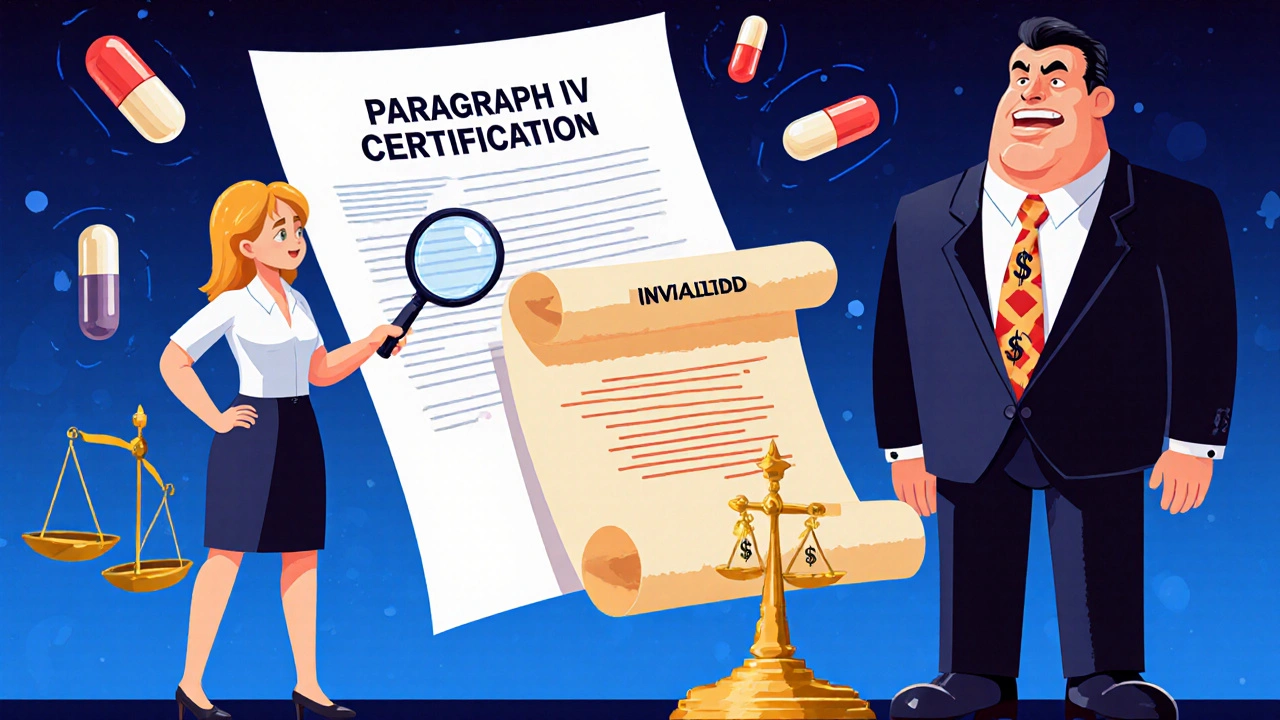When a brand-name drug company holds a patent, it can block generic versions from entering the market for years. But there’s a legal loophole-actually, it’s a carefully designed part of U.S. drug law-that lets generic manufacturers challenge those patents before the drug even hits shelves. This is called a Paragraph IV certification, and it’s one of the most powerful tools in the fight to lower drug prices.
What Exactly Is a Paragraph IV Certification?
It’s not a lawsuit. It’s not a protest. It’s a formal statement buried inside an Abbreviated New Drug Application (ANDA)-the paperwork a generic drug maker files to get FDA approval. In this statement, the generic company declares that one or more patents listed for the brand-name drug are either invalid, unenforceable, or won’t be infringed by making or selling the generic version. This isn’t just a guess. The law requires them to lay out the factual and legal reasoning behind their claim. It has to be detailed enough to convince a judge later. The FDA doesn’t decide if the patent is valid-that’s up to the courts. But the Paragraph IV certification triggers the legal process that forces the brand-name company to defend its patent in court before the generic can launch. This mechanism was created by the Hatch-Waxman Act of 1984. Before that, generic companies had to wait until every patent expired, even if those patents were weak or just minor tweaks to the original drug. Hatch-Waxman balanced two goals: protect innovation by giving brand companies enough time to recoup R&D costs, and speed up access to cheaper generics by giving them a legal way to challenge unnecessary patents.How It Works: The 4-Step Legal Process
There’s a strict sequence here. Skip a step, and your application gets rejected.- File the ANDA with Paragraph IV certification. The generic company submits its application to the FDA, including the detailed legal argument that the patent is invalid or won’t be infringed.
- Send a notice letter. Within 20 days, they must mail a copy of that certification to the brand-name company and the patent holder. This letter isn’t a warning-it’s a legal trigger. It says, ‘We’re challenging your patent. Sue us if you want to stop us.’
- Wait for a lawsuit. The brand company has 45 days to file a patent infringement lawsuit. If they do, the FDA automatically puts a 30-month hold on approving the generic. That’s not a delay-it’s a pause button. The case goes to court, and the generic can’t sell until the court rules or the 30 months expire, whichever comes first.
- Win or lose. If the generic wins, they can launch immediately. If they lose, they wait until the patent expires. But if they’re the first to file, they get a huge reward: 180 days of exclusive rights to sell the generic, with no competition.
Why This Matters: The 180-Day Exclusivity Prize
The real power of Paragraph IV isn’t just challenging patents-it’s the prize for winning. The first generic company to file a successful Paragraph IV certification gets 180 days of market exclusivity. During that time, no other generic can enter. That’s not just a head start-it’s a monopoly. For a blockbuster drug like a cholesterol pill or a diabetes medication that sells for billions, 180 days of exclusivity can mean hundreds of millions in revenue. Apotex made over $1.2 billion in 180 days after beating GlaxoSmithKline’s patent on Paxil in 2004. That’s why companies spend millions on lawyers and patent experts just to be first in line. But here’s the catch: you can lose that exclusivity. If you don’t get FDA approval within 30 months after filing, or if you withdraw your application, or if you change your patent challenge after filing, the exclusivity vanishes. Teva lost its 180-day window on Copaxone in 2017 because it didn’t get tentative approval on time. Suddenly, five other generics flooded the market-and Teva’s big payday disappeared.
How It Compares to Other Patent Certifications
Not every generic company challenges patents. In fact, most don’t. There are three other types of patent certifications under Hatch-Waxman:- Paragraph I: ‘This drug isn’t patented.’ Used in about 5% of cases. Low risk, no reward.
- Paragraph II: ‘The patent will expire soon.’ Used in 15% of cases. You wait, then launch on day one after expiry.
- Paragraph III: ‘We’ll wait until the patent expires.’ Used in 20% of cases. Safe, predictable, but no early entry.
- Paragraph IV: ‘This patent is weak or doesn’t apply.’ Used in 60-70% of ANDAs. High risk, high reward.
The Cost of Challenging a Patent
You think winning a patent case is expensive? It’s worse than you imagine. The median cost of a Paragraph IV lawsuit is $12.7 million, according to Fish & Richardson’s 2022 report. Some cases cost over $15 million. Why so much? Because these aren’t simple cases. They involve complex chemistry, patent claims written in legalese, expert witnesses, discovery, and appeals. Leading patent law firms charge $750 to $1,200 an hour just to draft the initial legal opinion. And it’s not just about money. The 30-month stay means you’re sitting on a product you can’t sell for two and a half years. If you lose, you’ve spent millions and gained nothing. If you win, you get 180 days of exclusivity-but then you’re flooded with competitors. The math only works if the drug is a blockbuster.What’s Changing Now?
The rules aren’t static. In 2023, the Supreme Court’s decision in Amgen v. Sanofi made it harder to invalidate patents by requiring the patent holder to prove their invention works across the entire scope of the claim-not just one version. That’s a big deal for biologics and complex drugs. Also, brand companies are stacking patents. One drug might have 15 patents covering everything from the pill’s color to the way it’s packaged. This is called a ‘patent thicket,’ and it’s designed to make Paragraph IV challenges more expensive and risky. In 2022, 63% of generic manufacturers said patent thickets made challenges harder than they were five years ago. On the flip side, the FDA’s 2023 Orange Book Modernization Act forced companies to list patents more accurately. That’s cutting down on ‘junk patents’-ones that shouldn’t have been listed in the first place. Another trend: more generic companies are now filing for Inter Partes Review (IPR) at the Patent Trial and Appeal Board (PTAB) at the same time as their Paragraph IV challenge. IPR is cheaper and faster than court. If the PTAB cancels the patent, the court case becomes easier to win.
Why This System Still Works
Despite the costs and complexity, Paragraph IV certifications have saved the U.S. healthcare system over $1.7 trillion since 1984, according to the FDA. In 2022 alone, generic drugs saved $460 billion. The system isn’t perfect. There are ‘pay-for-delay’ deals where brand companies pay generics to delay entry-something the FTC has been fighting since 2010. But even with those, Paragraph IV remains the most effective tool for breaking monopolies on expensive drugs. For patients, it means faster access to cheaper meds. For generic companies, it’s a high-stakes gamble with massive rewards. For the system, it’s the only legal way to force competition before patents expire.Who Uses This the Most?
The top five generic manufacturers-Teva, Viatris, Sandoz, Hikma, and Amneal-account for 58% of all Paragraph IV filings. These aren’t small players. They have legal teams dedicated to patent challenges. They track patent expirations years in advance. They don’t wait until the last minute. They start planning 36 to 48 months before a patent expires. And they’re not just going after simple pills anymore. More challenges are targeting complex generics-injectables, inhalers, topical creams-where manufacturing is harder and patents are more valuable. Evaluate Pharma predicts a 78% increase in these types of challenges by 2028.Final Reality Check
Paragraph IV certifications aren’t for the faint of heart. They require deep legal knowledge, serious money, and patience. But for the right drug, they’re the only way to bring down prices fast. If you’re a patient waiting for a generic version of a $2,000-a-month drug, this legal process is why you might get it for $50 in two years instead of ten. If you’re a generic company, it’s the difference between survival and bankruptcy. And if you’re a brand-name company, it’s the reason you have to keep innovating-or risk losing your monopoly. It’s not magic. It’s law. And it’s working.What happens if a generic company files a Paragraph IV certification but doesn’t win the lawsuit?
If the brand-name company wins the lawsuit, the generic drug cannot be approved by the FDA until the patent expires. The generic company loses its chance for 180-day exclusivity and must wait like every other competitor. Any money spent on litigation is lost, and the product sits on the shelf.
Can a generic company challenge multiple patents with one Paragraph IV certification?
Yes. A single Paragraph IV certification can challenge all patents listed for the brand-name drug in the FDA’s Orange Book. The generic company must list each patent and explain why each one is invalid or won’t be infringed. This is common because brand companies often file multiple patents covering different aspects of the drug-formulation, dosage, method of use, etc.
Why do brand-name companies sue so quickly after receiving a Paragraph IV notice?
They have to. The law gives them only 45 days to file a lawsuit. If they don’t, the generic company can launch immediately without any legal hold. Most brand companies file within the deadline because letting a generic enter early means losing millions in sales. Even if the patent is weak, they often sue to trigger the 30-month stay and delay competition.
What’s the difference between a Paragraph IV certification and an IPR proceeding?
A Paragraph IV certification is filed with the FDA as part of a generic drug application and triggers a federal court lawsuit. An Inter Partes Review (IPR) is a separate proceeding at the U.S. Patent and Trademark Office’s Patent Trial and Appeal Board (PTAB), which is faster and cheaper than court. Many generic companies now use both: file an IPR to weaken the patent, then use that ruling to strengthen their Paragraph IV case in court.
Can a brand-name company launch its own generic version during the 180-day exclusivity period?
Yes-this is called an ‘authorized generic.’ The brand company can license its own drug to a generic manufacturer and sell it under a different label during the 180-day window. The FTC has challenged this as anti-competitive because it blocks other generics from entering, even if they won the challenge. Courts have ruled it’s legal, but it’s controversial and reduces the value of the exclusivity prize.
How long does it typically take to resolve a Paragraph IV lawsuit?
Most Paragraph IV lawsuits take 2 to 5 years to resolve. The 30-month stay limits how long the FDA can delay approval, but courts can extend or shorten it. Some cases settle early. Others go to trial and appeal. The average time from filing to generic launch is about 3.5 years, though some drag on longer if appeals are filed.



Asha Jijen
This whole system is wild. Why do we even need lawyers to decide if a pill can be sold? Just let generics in already.